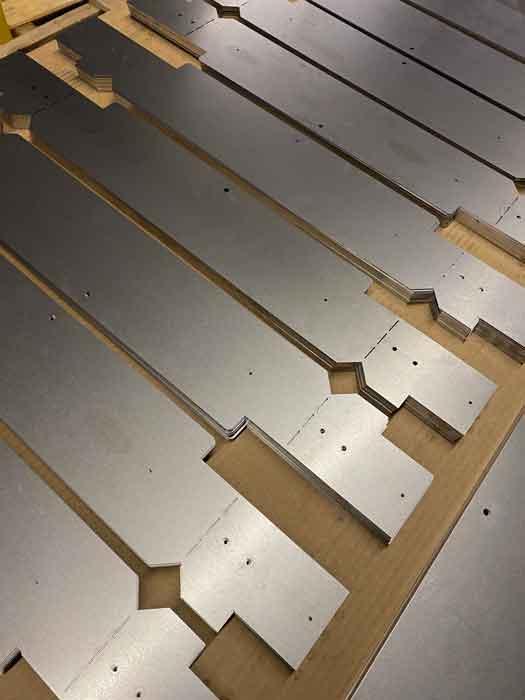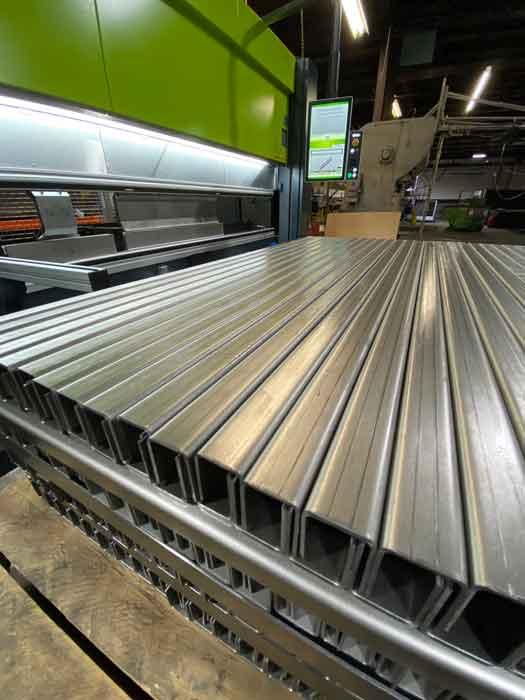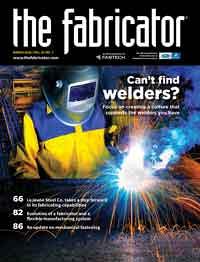Editor-in-Chief
- FMA
- The Fabricator
- FABTECH
- Canadian Metalworking
Categories
- Additive Manufacturing
- Aluminum Welding
- Arc Welding
- Assembly and Joining
- Automation and Robotics
- Bending and Forming
- Consumables
- Cutting and Weld Prep
- Electric Vehicles
- En Español
- Finishing
- Hydroforming
- Laser Cutting
- Laser Welding
- Machining
- Manufacturing Software
- Materials Handling
- Metals/Materials
- Oxyfuel Cutting
- Plasma Cutting
- Power Tools
- Punching and Other Holemaking
- Roll Forming
- Safety
- Sawing
- Shearing
- Shop Management
- Testing and Measuring
- Tube and Pipe Fabrication
- Tube and Pipe Production
- Waterjet Cutting
Industry Directory
Webcasts
Podcasts
FAB 40
Advertise
Subscribe
Account Login
Search
A recipe for quick company growth in metal fabrication
Two years after being acquired, an Archdale, N.C.-based fabricator has completely reinvented itself
- By Dan Davis
- March 2, 2020
- Article
- Laser Cutting
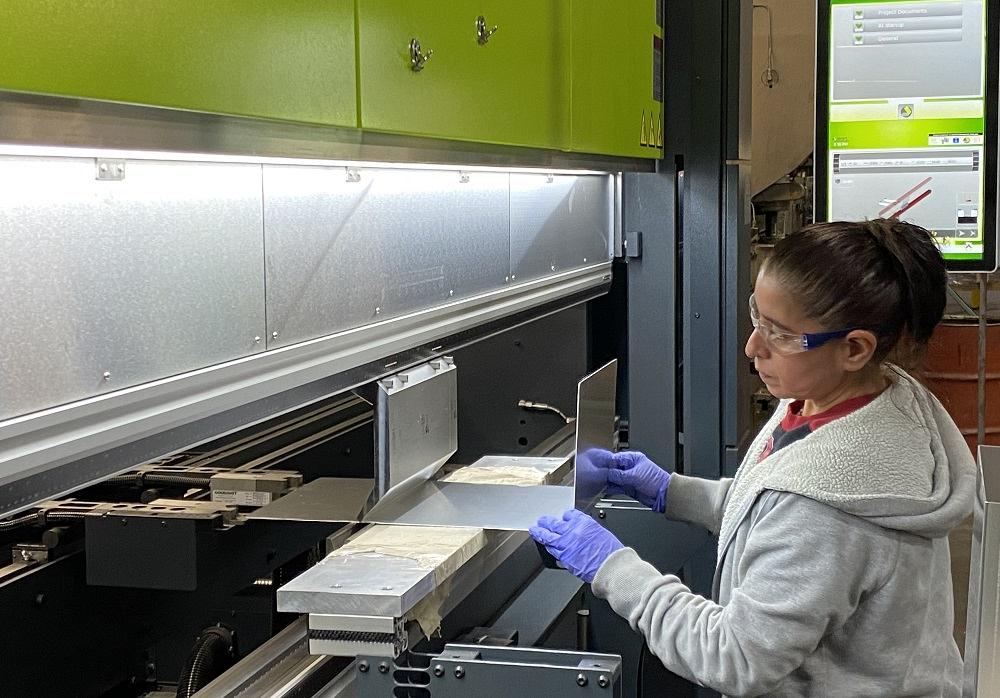
At US Metal Crafters, Archdale, N.C., a new electric press brake with automated backgauging keeps up with parts coming off the company’s two new fiber laser cutting machines. Photos courtesy of Meredith Barnes, US Metal Crafters.
If you are interested in turnaround stories, US Metal Crafters is a good one. It’s changed from a simple mom-and-pop fabricating shop into a modern manufacturing operation looking to serve and grow with the large OEMs near its Archdale, N.C., home base and elsewhere as well.
Steve McDaniel, who owns Kernersville, N.C.-based US Duct, a manufacturer of ducting, fittings, industrial ventilation systems, and tubing products, purchased what would become US Metal Crafters in late 2018. US Duct had purchased a metal clamp product from Speed Metal and liked that the metal fabricator was able to stay true to its name—supplying the clamp in a reasonable amount of time when others couldn’t.
The unique aspect of this relationship was that a Chinese group owned Speed Metal. It had purchased IVS Metal Stamping five years before. The Chinese owners eventually moved most of the production overseas, leaving Speed Metal to close. That’s when the U.S. company stepped in to purchase the Chinese-owned shop, a scenario that doesn’t happen every day in domestic manufacturing circles.
Since taking over the company, McDaniel and partners have done much more than celebrate the fact that US Duct has a local and reliable source for fabricated clamps. They have changed the trajectory of US Metal Crafters’ business in a major way. They have developed a new customer focus, increased the workforce from a handful of employees to more than 30, and invested more than $1 million in new technology. McDaniel has told the North Carolina trade press that sales revenues could reach $8 million in 2020. That’s not too bad for a shop left to die.
“We’ve completely switched who we are and turned it into a legitimate metal fabrication facility,” said Scott Hansen, US Metal Crafters national sales manager.
Just how was this transformation achieved in such a short time frame? Having the right location, plan, and technology mix helped to put US Metal Crafters on the right path for success.
Right Place, Right Time
The growth of the Sun Belt’s economies is not a new trend, but it’s still a developing story. Population shifts are occurring as people leave the Midwest and Northeast in search of a warmer climate, lower cost of living, and lower tax burden. Manufacturing companies also have been a part of this shift, taking advantage of an expanding working-age population and infrastructure that has been created over the last 25 years to support these companies. The rise of vehicle manufacturing in states like Alabama, Georgia, Mississippi, South Carolina, and Tennessee is just one example of how manufacturing has found a home in the southeastern U.S.
Archdale, N.C., is conveniently located to most of this economic activity. It’s only about 360 miles from Atlanta and less than 500 miles from Nashville. (It’s actually less than 500 miles from Philadelphia as well, so the East Coast is covered too.) US Metal Crafters actually can call some of the country’s biggest OEMs “neighbors,” as they are only a state or two away. These are some of the largest manufacturers of agricultural, construction, and hardware equipment. You might also consider Archdale a “suburb” of High Point, N.C., the hub of furniture-making in the U.S. For a provider of fabricating services, Archdale is a pretty good place to be.
Hansen said that the acquisition of Speed Metal was made with location in mind. OEMs in the area, and potentially elsewhere, are looking for metal fabricating assistance.
“Quite frankly, OEMs don’t want to manufacture anymore. They outsource a lot of this,” Hansen said. “These companies want products delivered to them, coming into the door all ready for assembly. As a result, most of the manufacturing processes have moved elsewhere, which has helped to facilitate our own growth,” Hansen said.
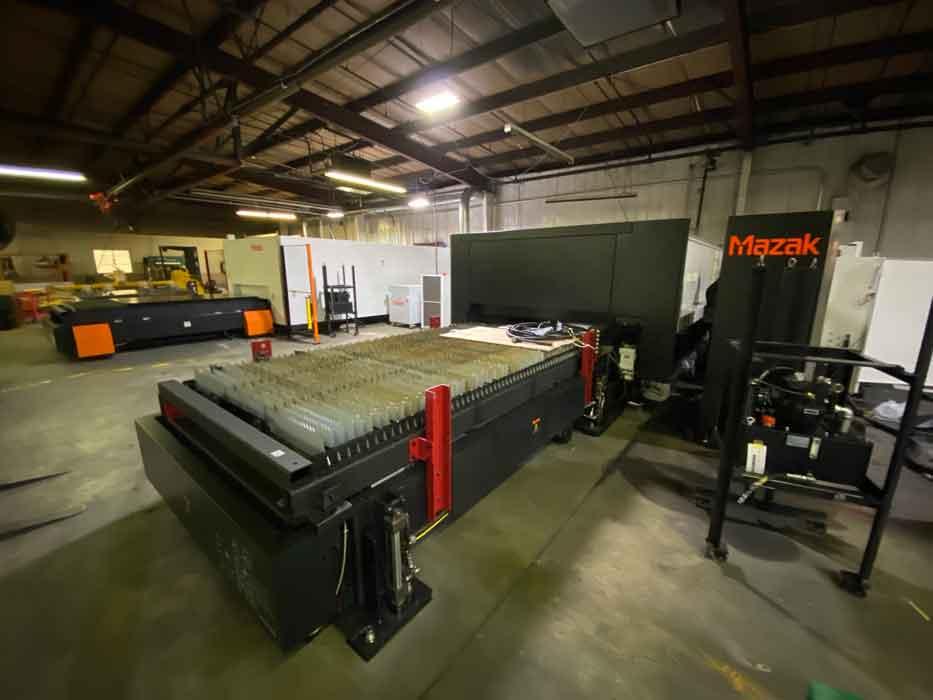
US Metal Crafters purchased an 8-kW fiber laser cutting machine in late 2019 only months after investing in a 3-kW machine in the first quarter of the year.
Defining the Right Customer
In gambling circles, the phrase “the trend is your friend” relates to recent history. If a team has lost its last five games on the road against teams with a winning record, the trend suggests that the same team will lose its sixth road game when they face another team with a winning record. In metal fabricating, following the trend can pay off as well.
Hansen said that if US Metal Crafters wanted to shed its past as a mom-and-pop shop, it needed to chase a new customer profile. It needed to steer away from the customer that would see the company sign, pull into the parking lot, walk through the front door, and ask for a quote on a metal part sketched out on a napkin or a shoddily made prototype built in somebody’s shed.
“We’re looking to work with metal parts up to about 1¼ inch maximum thickness. We want high production runs because we’re geared up for that,” Hansen said. US Metal Crafters also will take on custom fabrication work, but the desire is to tackle large-volume runs.
The acquisition of Speed Metal gave US Metal Crafters stamping, tool and die manufacturing, and maintenance capabilities. (Hansen pointed out that the tool and die expertise is particularly helpful in establishing partnerships with OEM customers because the company can not only create a prototype part, but also build the tooling and ramp up production for hundreds or even thousands of parts. Also, by having an in-house tool and die shop, US Metal Crafters can shave weeks off the build time for the tooling that might otherwise be lost if the tooling work was outsourced. In the end, its OEM customers work with only one company during the entire life cycle of the metal part.) The metal fabricator also has roll forming capability, which has proved useful in projects such as fabricating frames for solar panel installations, and a paint line.
At the time of the acquisition, Speed Metal had an old laser cutting machine and some old manual press brakes. The laser cutting machine was used to fulfill large orders that perhaps weren’t needed right away or that didn’t require the cleanest of edges. The press brakes were available for bending, but they were of no real use in delivering a lot of parts in a short time frame. As a result, investment in new fabricating technology to support the hunt for OEM contract manufacturing business was needed.
Putting the Right Technology in Place
In the first quarter of 2019, US Metal Crafters purchased a 3-kW Mazak Optiplex Champion 3015 fiber laser cutting machine and a SafanDarley 100T electric press brake. Hansen said the timing was perfect because the fabricator filled up the capacity in a matter of months.
The fiber laser gave the company the ability to cut mild steel up to ¾ in. and stainless steel and aluminum up to ½ in. It was much faster than the old technology it replaced, but it turned out not to be fast enough to keep up with all the work being thrown its way.
In fact, it was only a little over six months after US Metal Crafters purchased its first fiber laser that the fab shop contacted its distributor, Capital Machine Technologies, inquiring about another one. In November 2019 it purchased an 8-kW Mazak 3015 OPTIPLEX Fiber III to increase its laser cutting capacity.
It now can cut mild steel up to 1 in. and stainless steel and aluminum up to 1 in. The new laser cutting machine also has a two-pallet system connected to it, giving the shop the chance to maximize processing time, as it can unload parts and a skeleton and load a new sheet on one pallet while the other pallet is inside the machine’s cutting chamber. When one cutting job is done, the other pallet is ready to be loaded into the protective enclosure, and the cycle repeats itself.
The OPTIPLEX Fiber III also is equipped with advanced cutting technologies to minimize human intervention in the cutting process. It has automated focus positioning, nozzle cleaning, and nozzle changing. The machine’s control software also adjusts the beam diameter so that the beam is shaped optimally to cut a specific material type at a specific material thickness.
Hansen said the new laser cutting machine cuts at least three times as fast as the 3-kW model. Even with the new laser cutting speed, US Metal Crafters has had to expand production hours to keep up with the laser cutting work. It’s now running its laser cutting machines over five days, instead of just four days.
Meanwhile, the SafanDarley press brake has been able to keep up with the bending work.
“When we have the parts that are coming off the laser as fast as they’re coming off, we need something that can do multiple bends on them very quickly. The press brake with fully automated gauging can do this,” Hansen said. “We’re not having a bunch of downtime or setting up multiple machines to run multiple bends, and we do it much more efficiently because everything is computerized. It also allows us to bend with a lot more accuracy.”
Bending jobs are created with an offline software package called AutoPOL, which accommodates 28 different types of 3D solid model formats. The software creates a flat pattern of the unfolded part and also provides the tooling setup data to the machine. The brake uses this data to illuminate the LED lights on the upper and lower tool clamping system. These LED lights, part of the brake’s Smart Tool Locator, indicate precisely where on the press brake the tools need to be loaded in the machine to run every job.
When the job is ready for the press brake, all the operator has to do is call it up, load the appropriate tools, and form the part. The monitor provides a guide as to the bends and sequence needed to complete the job. The process of loading a program, loading the tools, and running a part that meets quality specs typically can be done in less than five minutes, according to Shaun Reiff, Capital Machine Technologies branch manager for the Carolinas and Virginia.
US Metal Crafters sent the plant manager and two operators down to the Capital Machine Technologies office in Tampa, Fla., to learn how to program and operate the new press brake. Hansen said that since the training, the operators and machine haven’t had any issues keeping up with the bending work, even as they try to send all bending jobs to the new brake to avoid using the manual brakes if possible.
“We used to train operators out in the field on the fabricator’s floor,” Reiff said. “We never got the attention of the operators like we really needed that way. Now with the ability to train people at one of our tech centers, we really go deeper and maximize the student-to-trainer relationship. We have check lists that we know we have to go over with the operators, and we know that we are doing a better job of getting them up to speed more quickly than before.”
The modern fabricating equipment has made a marked difference in the shop’s ability to get parts out the door and according to specs.
“The great thing about the laser and the press brake is once the files are in there, you only need to create the program once,” Hansen said. “If it’s a repetitive part, you can just call it up and hit go.”
Prepared for the Future in the Right Way
US Metal Crafters is positioning itself to handle future growth. It has plenty of room in its 135,000-square-foot facility to grow into, either for more machine tools or to take on assembly work. It has achieved ISO 9001:2015 certification and is working to complete its International Traffic in Arms Regulations (ITAR) compliance, which will allow it to be an aggressive pursuer of military work.

The 8-kW laser cutting machine in particular gives US Metal Crafters the ability to cut thick materials, something it couldn’t do with any efficiency before the arrival of the new equipment.
The fabricator also is looking at its work flow to ensure good shop floor habits begin now and grow with the company, hopefully avoiding headaches in the future as production stresses inevitably increase with more work. For example, in the laser cutting area, a new crane was installed to assist with the moving of heavy plate onto the pallets that are then moved into the laser cutting machine’s cutting chamber. When the shop had only one fiber laser, operators used a crane affixed to a beam in the ceiling. The arrival of the second laser cutting machine made that crane obsolete as operators needed it to move between the lasers to maximize green-light time on the machines.
Even in the early days of this new metal fabricating endeavor, US Metal Crafters is trying to instill lean thinking on the shop floor. Hansen said that this is especially evident in raw material inventory.
“We don’t inventory a tremendous amount of material because most of what we make right now is made to order. As soon as the material gets in, it’s being run,” he said.
Hansen added that the company may be looking to boost its finishing capabilities, perhaps adding powder coating. It’s already taken the steps to install a nitrogen generator used in the laser cutting process. (Using nitrogen as an assist gas during laser cutting helps to prevent oxidation on the laser-cut edges and improve powder coating adhesion to the metal parts.)
The company also is connecting with customers in places as far-flung as the Virgin Islands. The right plan has led to the desired outcome.
Hansen mentioned that he wouldn’t be surprised if another machine tool order was on the horizon in 2020.
“It’s nice that we can control so much of the production process under one roof—oversee the fabricating and oversee the quality. That way we can be responsible for everything, and we’re not at the mercy of a contractor to complete a project,” Hansen said.
About the Author

Dan Davis
2135 Point Blvd.
Elgin, IL 60123
815-227-8281
Dan Davis is editor-in-chief of The Fabricator, the industry's most widely circulated metal fabricating magazine, and its sister publications, The Tube & Pipe Journal and The Welder. He has been with the publications since April 2002.
Related Companies
subscribe now

The Fabricator is North America's leading magazine for the metal forming and fabricating industry. The magazine delivers the news, technical articles, and case histories that enable fabricators to do their jobs more efficiently. The Fabricator has served the industry since 1970.
start your free subscription- Stay connected from anywhere

Easily access valuable industry resources now with full access to the digital edition of The Fabricator.

Easily access valuable industry resources now with full access to the digital edition of The Welder.

Easily access valuable industry resources now with full access to the digital edition of The Tube and Pipe Journal.
- Podcasting
- Podcast:
- The Fabricator Podcast
- Published:
- 04/16/2024
- Running Time:
- 63:29
In this episode of The Fabricator Podcast, Caleb Chamberlain, co-founder and CEO of OSH Cut, discusses his company’s...
- Trending Articles
How to set a press brake backgauge manually

Capturing, recording equipment inspection data for FMEA

Tips for creating sheet metal tubes with perforations

Are two heads better than one in fiber laser cutting?

Hypertherm Associates implements Rapyuta Robotics AMRs in warehouse

- Industry Events
16th Annual Safety Conference
- April 30 - May 1, 2024
- Elgin,
Pipe and Tube Conference
- May 21 - 22, 2024
- Omaha, NE
World-Class Roll Forming Workshop
- June 5 - 6, 2024
- Louisville, KY
Advanced Laser Application Workshop
- June 25 - 27, 2024
- Novi, MI
























